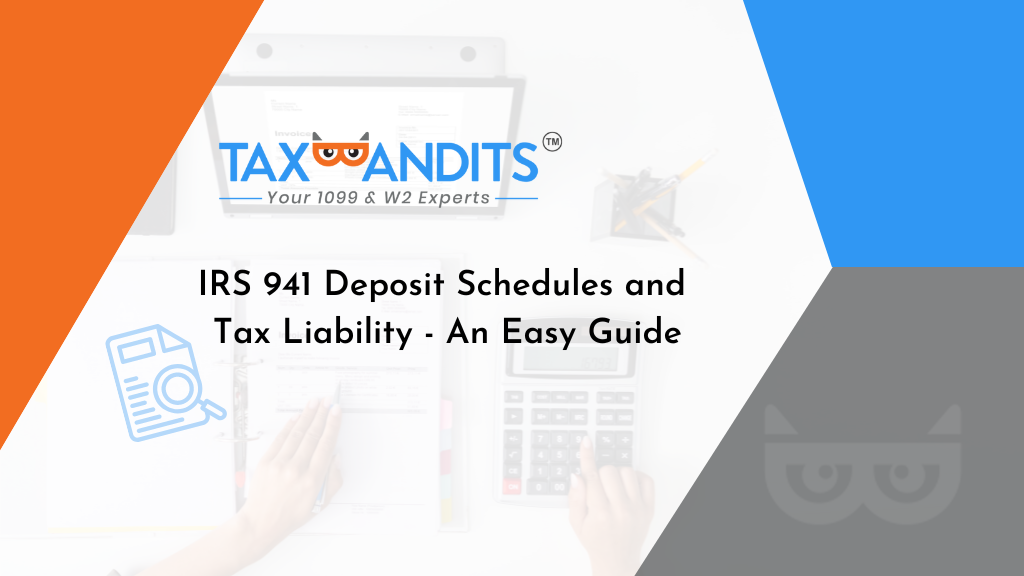IRS 941 Deposit Schedules and Tax Liability – An Easy Guide
reading time: 12 minute(s)

When filing Form 941, many filers wonder how to determine the business’ deposit schedule and tax liability.
To help make filing easier than ever, we are breaking down the difference between deposit schedules and taking a look at what exactly tax liability is!
941 Deposit Schedules
A business’ deposit schedule determines when to deposit social security, medicare, and withheld federal income taxes. There are two types of deposit schedules, monthly and semiweekly.
Determining your the deposit schedule for your business
A business needs to know which deposit schedule it is required to follow before beginning each calendar year. This is determined using the total tax liability it reported on Form 941, line 12 during a lookback period.
The look back period of the tax year 2023 is July 1, 2021, to June 30, 2022.
- July 1st – September 30th
- October 1st – December 31st
- January 1st – March 31st
- April 1st – June 30th
If the tax amount reported by the business during the lookback period was $50,000 or less, it is a monthly schedule depositor.
If the tax amount reported by the business during the lookback period was greater than $50,000, it is a semiweekly schedule depositor.
A closer look at deposit periods
The days tax liabilities are accrued between each deposit due date are the deposit period.
- Deposit period of monthly schedule depositors:
- Each calendar month of the quarter
- Deposit periods of semiweekly schedule depositors:
- Wednesday – Friday
- Saturday – Tuesday
Making timely IRS deposits
The deposit schedule isn’t based on how often employees are paid or deposits are made.
For monthly schedule depositors:
- The deposit for a month should be made by the 15th of the next month.
For semiweekly schedule depositors:
- The deposit for Wednesday, Thursday, and Friday should be made by next Wednesday.
- The deposit for Saturday, Sunday, Monday, and Tuesday should be made by next Friday.
Per the IRS, if a deposit is required to be made on a day that isn’t a business day, the deposit is considered timely if it is made by the close of the next business day.
Note: On any day of a deposit period, if the business accrues taxes of $100,000 or more, the tax must be deposited by the next business day, regardless of depositor type.
What is Form 941 tax liability?
- A business’ tax liability is based on when wages or other payments were made.
- Its tax liability must equal the amount it reports on Line 12 of Form 941.
- The tax liability is not based on the amount of deposits that were made during the quarter.
How does the deposit schedule and tax liability apply to Form 941?
When filing Form 941, a businesses’ deposit schedule and tax liability are reported on Part 2:
There are three deposit schedule options on Line 16.
The first option applies if:
- Line 12 on the return is less than $2,500.
- Or, if line 12 on the return for the previous quarter was less than $2,500, and a $100,000 next-day deposit obligation wasn’t incurred during the current quarter.
The second option applies if:
- The business was a monthly schedule depositor for the entire quarter.
- If this option is selected, the filer is instructed to fill out the tax liability for each month and go to part 3.
- The total liability of the three months must equal the amount on Line 12 of Form 941.
The third option applies if:
- The business was a semiweekly schedule depositor for any part of the quarter.
- If this option is selected, the filer is instructed to complete Schedule B and go to part 3.
- The total liability reported on 941 Schedule B must equal the amount on Line 12 of Form 941.
Easy and Accurate 941 E-filing with TaxBandits
Form 941 can be easily e-filed with the IRS using TaxBandits!
Our e-filing process is easy and efficient. Built-in error checks using the IRS Business Rules and automatic tax calculations make filing an accurate form easier than ever. You can easily complete Form 941 Schedule B during the e-filing process as needed.
Our team is also here to help you through the process, we offer excellent live customer support. Get started with TaxBandits today by creating your free account! Pricing starts at just $5.95/form. Below are the steps for e-filing 941 with TaxBandits:
If you already have a TaxBandits account, click here to sign in and begin filing!
Step 1: Enter Form 941 Details
Step 2: Review the Summary Form 941
Step 3: Pay & transmit the Form 941 to the IRS
With TaxBandits, you can easily meet your Form 941 deadline for the second quarter of 2023 on July 31st!


Leave a Comment